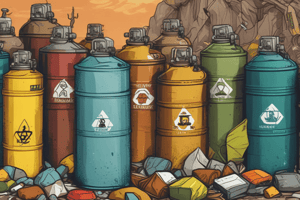Podcast
Questions and Answers
What are three general categories of toxic waste products?
What are three general categories of toxic waste products?
Chemical wastes, radioactive wastes, and medical wastes.
Explain how bioaccumulation of heavy metals, such as lead and mercury, can affect food chains.
Explain how bioaccumulation of heavy metals, such as lead and mercury, can affect food chains.
Heavy metals increase in concentration at higher levels of the food chain, posing a greater risk to organisms that consume contaminated prey.
Name three common household products that can be classified as toxic or hazardous waste if improperly disposed of.
Name three common household products that can be classified as toxic or hazardous waste if improperly disposed of.
Old batteries, pesticides, paint, and car oil.
What makes radioactive wastes particularly dangerous?
What makes radioactive wastes particularly dangerous?
Describe how asbestos can affect human health.
Describe how asbestos can affect human health.
How can using natural compost as fertilizer reduce toxic waste?
How can using natural compost as fertilizer reduce toxic waste?
Explain why it is important to avoid using commercial household cleaners in large amounts.
Explain why it is important to avoid using commercial household cleaners in large amounts.
What is the primary concern regarding clinical wastes?
What is the primary concern regarding clinical wastes?
Give an example of a natural alternative to toxic drain cleaners.
Give an example of a natural alternative to toxic drain cleaners.
How do POPs (persistent organic pollutants) pose a risk to the environment and human health?
How do POPs (persistent organic pollutants) pose a risk to the environment and human health?
How can the use of water-based paints contribute to reducing hazardous waste?
How can the use of water-based paints contribute to reducing hazardous waste?
What is the significance of knowing the effects of hazardous waste, especially to humans?
What is the significance of knowing the effects of hazardous waste, especially to humans?
Why is it important to dispose of hazardous waste in special disposal units provided by the locality?
Why is it important to dispose of hazardous waste in special disposal units provided by the locality?
How can using natural alternatives like citronella oil help in reducing toxic waste?
How can using natural alternatives like citronella oil help in reducing toxic waste?
Explain how toxins from toxic waste can affect living organisms.
Explain how toxins from toxic waste can affect living organisms.
Describe how you can use natural alternatives for floor and metal polish.
Describe how you can use natural alternatives for floor and metal polish.
What measure can be used to reduce the amount of substances that clog drains?
What measure can be used to reduce the amount of substances that clog drains?
What are some products found in developed countries that become part of the toxic waste rivers?
What are some products found in developed countries that become part of the toxic waste rivers?
How do strong acids and alkalis contribute to toxic and hazardous waste?
How do strong acids and alkalis contribute to toxic and hazardous waste?
Give three examples of how Chromium is used.
Give three examples of how Chromium is used.
Flashcards
Hazardous or Toxic Waste
Hazardous or Toxic Waste
Harmful derivatives from activities like engineering, agriculture, and laboratories.
Toxic Waste
Toxic Waste
Waste that can cause death or injury to living organisms.
Sources of Toxic Waste
Sources of Toxic Waste
Industries, chemical laboratories and biological processes.
Hazardous Waste
Hazardous Waste
Signup and view all the flashcards
Types of Toxic Waste Products
Types of Toxic Waste Products
Signup and view all the flashcards
Chemical Wastes
Chemical Wastes
Signup and view all the flashcards
Carcinogenic
Carcinogenic
Signup and view all the flashcards
Radioactive Wastes
Radioactive Wastes
Signup and view all the flashcards
Medical Wastes
Medical Wastes
Signup and view all the flashcards
Arsenic
Arsenic
Signup and view all the flashcards
Asbestos
Asbestos
Signup and view all the flashcards
Cadmium
Cadmium
Signup and view all the flashcards
Chromium
Chromium
Signup and view all the flashcards
Clinical Wastes
Clinical Wastes
Signup and view all the flashcards
Cyanide
Cyanide
Signup and view all the flashcards
Lead
Lead
Signup and view all the flashcards
Mercury
Mercury
Signup and view all the flashcards
PCBs (Polychlorinated Biphenyls)
PCBs (Polychlorinated Biphenyls)
Signup and view all the flashcards
POPs (Persistent Organic Pollutants)
POPs (Persistent Organic Pollutants)
Signup and view all the flashcards
Strong Acids and Alkalis
Strong Acids and Alkalis
Signup and view all the flashcards
Study Notes
- Hazardous or toxic waste includes potentially dangerous byproducts from industries like engineering, agriculture, water treatment, construction, garages, labs, and hospitals.
- Toxic and hazardous waste can harm organisms through inhalation, ingestion, or absorption.
- Cities and municipalities often schedule specific collection days for household hazardous waste.
- Knowledge of the harmful effects of these wastes is necessary to allow preventive measures.
Toxic Waste
- Chemical waste can cause death or injury to living organisms.
- Waste containing pathogens such as used syringes can be toxic.
Sources of Toxic Waste
- Toxic waste comes from places like industries, chemical laboratories, and biological processes.
- Toxins are found in waste from households, offices, and commercial activities.
- Electronic device batteries, pesticides, cell phones and computers can become toxic waste.
Hazardous Waste
- Hazardous Waste includes corrosive, flammable, or chemically unstable materials, or ones with excessive toxins.
- Landfills are unsuitable for these materials, due to the risk of immediate or long-term harm to health.
Types of Toxic Waste
- Toxic waste is categorized into chemical, radioactive, and medical wastes.
Chemical Waste
- Corrosive, flammable, and reactive chemicals that produce explosive or toxic by-products are considered chemical wastes.
- Chemical wastes can be acutely poisonous, carcinogenic, mutagenic, teratogenic, and bioaccumulative (like heavy metals).
Radioactive Waste
- Elements and compounds that produce ionizing radiation, and any material interacting with them are radioactive wastes.
- Examples include rods and water used in nuclear power plants to control nuclear reactions.
Medical Waste
- Tissues and fluids with infectious organisms, along with containers, are medical wastes.
Sources, Causes, and Effects
- UNEP identifies 11 key toxic/hazardous substances.
Toxic/hazardous substances
- Arsenic: Used in electrical circuits, pesticides, and wood preservatives, it's also carcinogenic.
- Asbestos: Used for insulation and roofing/brake materials; inhaling its fibers can cause lung cancer and asbestosis.
- Cadmium: Found in batteries and plastics; can be inhaled or ingested, leading to lung damage, digestive issues, and kidney disease.
- Chromium: Used in furnaces, steel making, chrome plating, dyes, wood preserving, and leather tanning; it can cause cancer, bronchitis, and lung damage.
- Clinical wastes: Syringes and medication bottles can spread pathogens and harmful microorganisms.
- Cyanide: A poison in pesticides and rodenticides, leading to paralysis, convulsions, and respiratory distress in large doses.
- Lead: Found in batteries, paints, and ammunition; harmful to the nervous, reproductive, and kidney systems if ingested or inhaled.
- Mercury: Used in dental fillings, batteries, and chlorine gas production; exposure may cause birth defects, kidney, and brain damage.
- PCBs (Polychlorinated Biphenyls): Used in manufacturing, the utility industry, paints, and sealants; exposure can harm the nervous, reproductive, and immune systems, along with the liver.
- POPs (Persistent Organic Pollutants): In chemicals and pesticides, may lead to nervous and reproductive system issues and bio-accumulate in the food chain.
- Strong acids and alkalis: Used in manufacturing and industry, they can destroy tissues and cause internal damage.
- Household products are often overlooked as toxic when improperly disposed of such as old batteries, pesticides, paint, and car oil.
- Toxic waste can be reactive, ignitable, and corrosive.
Effects of Toxic/Hazardous Waste
- Toxic waste harms people, animals, and plants on land, in rivers, and in the air.
- Toxins like mercury and lead persist in the environment for years.
- Living organisms absorb toxins by consuming contaminated fish, animals, and plants.
- Every person is a contributor to hazardous waste generation.
Reduction Methods
- Simple changes in product usage can reduce hazardous waste, benefiting the environment.
Reducing Toxic Waste
- Commercial cleaners and laundry detergents are major contributors to hazardous waste.
- Using household ingredients like vinegar, soap, lemon juice, cornstarch, borax, and baking soda is a safer alternative.
- These natural ingredients can also be used for dishwashing, laundry, and bathroom cleaning.
- Natural compost, made from vegetable peels, coffee grounds, grass, and plant clippings, can be used as fertilizer.
- Homemade compost is more effective than commercial products and harmless to the environment.
- Compost is an excellent substitute for toxic weed killers, also helping avoid the need for pesticides and fertilizers which pose risk as hazardous waste.
- Natural repellents made from alternatives like garlic, onion, and soap can control pests on plants.
- Water-based paints should be used instead of oil-based paints which contain solvents that contribute to hazardous waste.
- Alternatives to toxic drain cleaners like a sewer snake or plunger, can be used unclog drains.
- Straining and pouring boiling water down the drain 3-4 times a month helps in preventing clogs.
- Furniture can be polished with lemon oil or olive oil combined with vinegar or lemon juice.
- Metals can be polished with baking soda, vinegar, or salt as opposed to using commercial polishes and varnishes.
- Follow hazardous waste disposal regulations in your locality.
- Drop off unused cleaners, fluorescent bulbs, batteries, pesticides, herbicides, sealants, polish, paint thinner, solvents, varnish, and oil-based paints at designated disposal units.
- Natural alternatives such as using citronella oil for insect repellent sprays and lotions.
- Removing sources that attract insects, such as standing water, can also reduce the need for repellents.
Studying That Suits You
Use AI to generate personalized quizzes and flashcards to suit your learning preferences.




